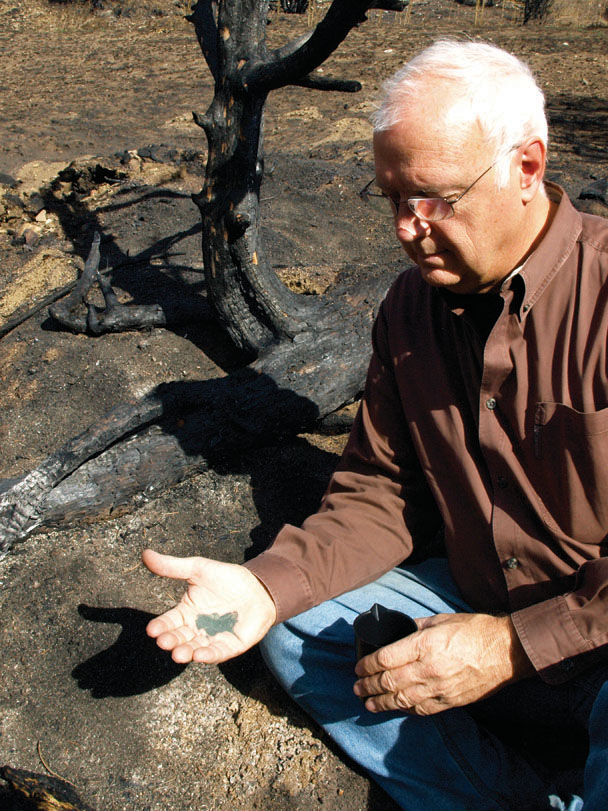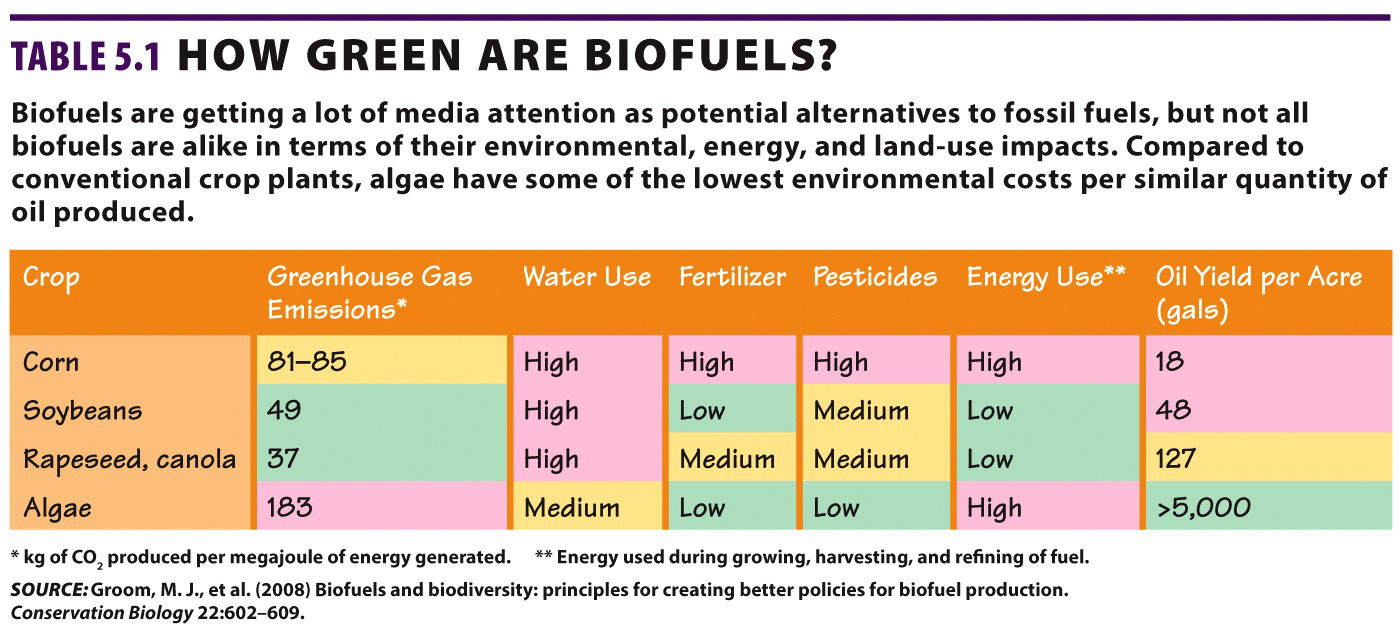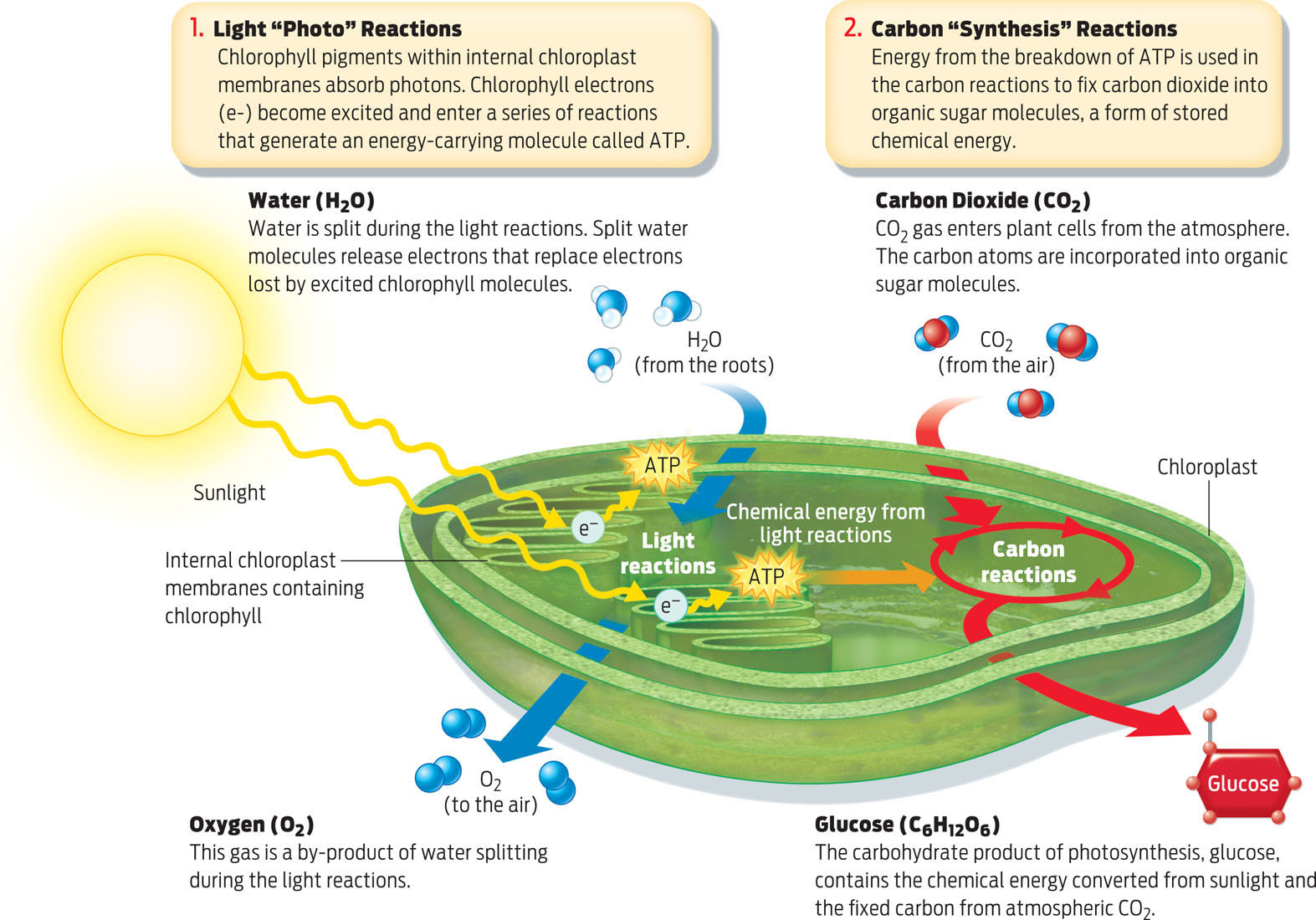FROM SUN TO FUEL
LIGHT ENERGY The energy of the electromagnetic spectrum of radiation that is visible to the human eye.
PHOTONS Packets of light energy, each with a specific wavelength and quantity of energy.
For heterotrophic humans, the idea of being able to subsist solely on sunlight, carbon dioxide, and water, seems remarkable. How can something as intangible as sunlight carry energy? If you’ve ever walked barefoot across a sandy beach on a hot summer day, you know that sunlight is a potent source of heat energy. You may also have a sense that certain colors absorb or reflect sunlight better than others—on a sunny day, wearing a reflective white shirt keeps you cooler than a black one that absorbs more of the sun’s rays.
These properties reflect the nature of light energy, which is part of the electromagnetic spectrum of radiation. Light energy from the sun travels to Earth in waves. These waves of light are made up of discrete packets of energy called photons. Photons of different wavelengths contain different amounts of energy, and different objects on earth absorb and reflect different wavelengths of light. Some of these wavelengths, when viewed by the human eye and interpreted by the human brain, appear to us as different colors (INFOGRAPHIC 5.8).
CHLOROPHYLL The pigment present in the green parts of plants that absorbs photons of light energy during the “photo” reactions of photosynthesis.
ADENOSINE TRIPHOSPHATE (ATP) The molecule that cells use to power energy-requiring functions.
When sunlight hits a green plant, for example, its leaves absorb red and blue wavelengths and reflect green wavelengths—which is why plants appear green to our eyes. The molecule that absorbs and reflects these wavelengths of light is the pigment chlorophyll—a crucial player in photosynthesis. It is chlorophyll that actually captures the energy of sunlight. During the “photo” reaction, chlorophyll molecules absorb energy from the red and blue wavelengths of sunlight. In addition to chlorophyll, plants and algae contain other pigment molecules that absorb and reflect other wavelengths of light, giving them their distinctive colors. But chlorophyll is the main pigment involved in photosynthesis. When red and blue photons of sunlight hit chlorophyll, the electrons in its atoms become excited. These excited electrons are used to generate an energy-carrying molecule known as adenosine triphosphate (ATP), which is used in the “synthesis” part of photosynthesis to make sugar (INFOGRAPHIC 5.9). (We’ll talk more about ATP, the cell’s “energy currency,” in Chapter 6.)
Plants use the sugar they make as food–as a source not only of chemical energy to power cellular reactions, but also as the building materials to make all the organic molecules critical to building a plant, including proteins, nucleic acids, and lipids (see Chapter 4). Many plants use much of their glucose to produce more complex sugar molecules such as starches, and to form plant products such as wheat grains and fruit. Microscopic, single-cell algae, on the other hand, waste little of their sugar making these elaborate plant parts. Instead, they pour most of it into making oil. And that’s what makes them so useful as fuel producers–they pack more bang for the buck. In some algae, oil constitutes more than half of their dry weight. Some algae species secrete the oil in order to adhere to other cells, whereas others accumulate the oil inside their bodies to control buoyancy. Still others use the oil as an efficient way to store energy.

Algae are especially popular right now, but they aren’t the only living organisms scientists use to make biofuels. Crop plants such as corn, soybeans, and rapeseed are also used. How do algae stack up against these other biofuels? Compared to corn-based ethanol and fuels made from plants like soybeans and rapeseed, algae take the prize in terms of how much fuel they can produce for the amount of space they take up. According to the U.S. Department of Energy, if American soybean farmers had converted all of their crops in 2007—about 64 million acres’ worth of soybeans—into biofuel, they would have provided the country with only enough diesel to meet 5% of the nation’s needs. On the other hand, if farmers had grown algae on this same amount of land in open ponds or containers, they would have produced enough fuel to supply all our country’s diesel needs. And because algae can be cultivated on land that is unsuitable for food crops, production of algal biofuel doesn’t compete with or take resources away from food production—a common criticism of corn-derived ethanol.
 Algae truly are the foundations of our entire planet.
Algae truly are the foundations of our entire planet.
–JIM SEARS
Extracting fuel from algae is also less energy intensive than extraction from other biofuel sources. To make ethanol, for instance, farmers typically start with corn, which requires more energy to grow than algae do. Then they have to ferment the corn into ethanol, and finally they must harvest the ethanol. It’s a multistep process that requires inputs of precious farmland, clean water, and energy. In addition, energy has to be converted first from sunlight into corn, and then from corn into ethanol, which means that some energy is wasted. Algae are far simpler life forms, and therefore more efficient: using sunlight and carbon dioxide, they produce fuel directly.
And they can be grown on poor-quality lands that cannot be cultivated for other crops, using both freshwater and saltwater that is not suitable for agriculture (TABLE 5.1) .

Which is not to say that all the bugs have been worked out yet, or that algae are a miracle solution to our energy woes. A 2012 report on algae biofuels by the National Academy of Sciences produced at the request of the U.S. Department of Energy found that scaling up algae biofuel production to meet a significant portion of our energy needs may prove extremely challenging, given the amount of water and nutrients required. Nevertheless, the report stresses that the promise of such fuels makes them worth continued research and development.

